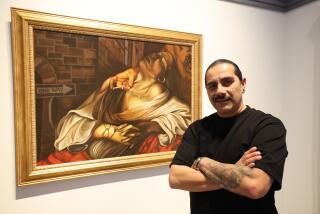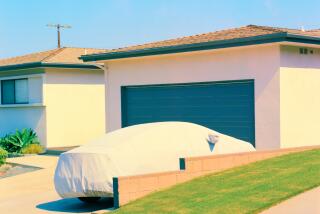Todd Carpenter paints urban and woodsy landscapes in a scientific light
Like many painters, Todd Carpenter is drawn to light. His densely wooded forests and apocalyptic-looking cityscapes — all rendered in muted grays or stark black and white — depict slices of sunlight between crowded tree trunks, glimmering tufts of smoke rising from industrial vents, luminescent cloud formations or swaths of early-morning haze skimming a lake’s surface.
Carpenter, however, sees light as more than a subject. It’s an experiment too.
Each of his paintings, all named after organic molecules that exist in plants, is a different approach to light, says Carpenter, who used to teach neuroscience at NewSchool of Architecture & Design in San Diego. His work aims to explore how viewers perceive light and navigate the world around them.
SIGN UP for the free Essential Arts & Culture newsletter >>
“I have a theory, going back to neuroscience, that there’s two ways we look at the world,” Carpenter says. “Kind of a symbolic way — the thing that’s connected to our language, our words — and the other side of our brain, that’s more raw, perceptual. I paint light because that part of the brain is just looking at shapes and shadows. I’m trying to tap into that crude system that sees space.”
Painting with a handcrafted palette knife that he makes from a Starbucks gift card — “It’s the perfect thickness and flexibility of plastic,” he says — Carpenter creates a geometric, almost three-dimensional feel to his tiny cities painted on board.
Working mostly from memory rather than photographs, these urban locations are imaginary amalgamations of Los Angeles, Seoul, Tokyo, Toronto and New York, he says, and his mountain landscapes are nebulous, vaguely reminiscent of Death Valley and areas east of the Sierra Nevada.
If this evokes a sense of sublime disorientation, that’s the point.
“You can feel lost in these,” Carpenter says of his work. “And that’s reassuring in a sense because there’s so many distractions — and that can be freeing.”
MORE:
How these 75-plus murals have turned three L.A. alleys into an outdoor art gallery
Royale Projects to open in downtown L.A. arts district
Doug Aitken explains how ‘Station to Station’ became 62 one-minute films, rolled into one
More to Read
The biggest entertainment stories
Get our big stories about Hollywood, film, television, music, arts, culture and more right in your inbox as soon as they publish.
You may occasionally receive promotional content from the Los Angeles Times.







